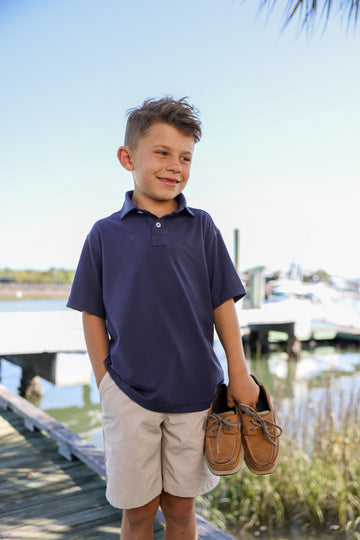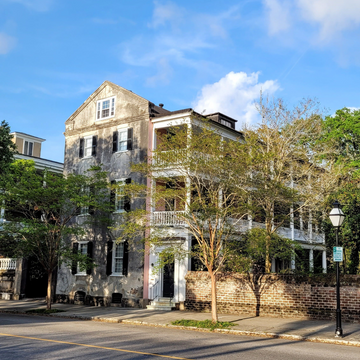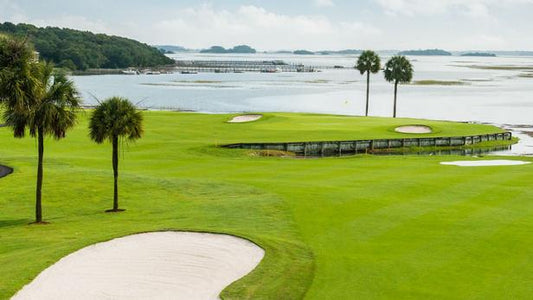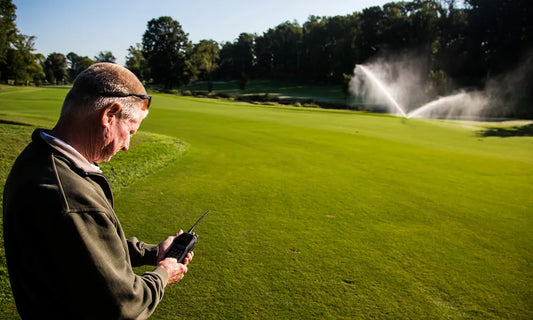Heritage Journal
The Harlestons Heritage Journal is where we share what inspires us—from the courses we love and the city we call home to the details that go into every piece we make.
It’s a look into the world around Harlestons, past and present.
Heritage Journal
From the Course to the Clubhouse: Our Guide to Effortless Golf Style
Effortlessly transition from the golf course to the clubhouse with Harlestons' multifunctional golf apparel. Discover how versatile pieces like the Performance Polo, Traveler Jacket, and Hybrid Vest offer the perfect blend of style and functionality for today’s modern golfer.
The Best Places to Visit in Charleston for Golf Enthusiasts
Discover the best golf courses in Charleston, SC, from the renowned Kiawah Island to hidden gems like Rivertowne Country Club. Whether you're a seasoned golfer or just starting out, explore Charleston’s top golf destinations and plan your ultimate golf getaway in the Lowcountry.
Sustainable Golf: How the Industry Has Gone Green in 2024
Discover how the golf industry is going green in 2024 with sustainable practices, from eco-friendly course management and water conservation to renewable energy and wildlife preservation. Learn how golf is embracing sustainability for the future of the sport.
The Growth of Virtual Golf: Revolutionizing the Future of the Game
Explore the rise of virtual golf and how technology is transforming the game, from making it more accessible to attracting younger players. Learn about virtual golf simulators, training benefits, and the future of this innovative sport.
Golf's Role in Networking: How it's More Important Than Ever
Discover how golf has become an essential tool for corporate networking and business success. Learn why more deals are sealed on the fairway and how to leverage golf for relationship-building, leadership development, and professional growth.
Golf Course Architecture: What Makes a Course Truly Great?
Explore the key elements that make golf course architecture truly great. From natural beauty and strategic design to sustainability and legendary courses, discover what sets the best golf courses apart.
Dressing for Work and Play: How Golfwear is Leading the Charge
Discover how golfwear is revolutionizing hybrid work fashion with its perfect blend of style, comfort, and versatility. From remote work to after-hours activities, golfwear offers the ideal wardrobe solution for today’s flexible lifestyle.
The Evolution of Men's Fashion in Golf: From Traditional Attire to Modern Performance Wear
Golf, a sport with deep historical roots, has long been associated with a certain style and elegance. Over the years, men's fashion in golf has evolved dramatically, reflecting broader societal changes, technological advancements, and shifts in the sport itself. From the traditional tweeds of the early days to today's sleek, performance-oriented attire, the journey of golf fashion is as fascinating as the game itself.The Early Days: 19th-Century Golf FashionIn the 19th century, golf was primarily a sport for the British elite, and the fashion of the time reflected this exclusivity. Men's golf attire was heavily influenced by the formal clothing of the Victorian era, with golfers donning heavy woolen jackets, tweed knickerbockers, and stiff collars. The fabrics were chosen more for their durability and warmth than for comfort or mobility, often making the game more challenging.Golfers of this era also wore flat caps, which provided some protection from the elements. However, the attire was far from practical, as the materials were heavy and restrictive, limiting movement and making it difficult to play in warm weather. The focus was on maintaining a distinguished appearance rather than enhancing performance, a stark contrast to today's golf fashion.The Role of British Aristocracy in Shaping Early Golf FashionGolf's association with the British aristocracy played a significant role in shaping its early fashion trends. The sport was considered a gentleman's game, and as such, it required a gentleman's attire. Tailored suits, waistcoats, and ties were common on the golf course, reflecting the social status of the players rather than the needs of the sport.As golf began to spread beyond the UK, these fashion norms were carried along, establishing a global standard for golf attire. The emphasis was on formality and tradition, with little consideration given to the functional requirements of the game.The 1920s: The Birth of Functional Golf FashionThe 1920s marked a significant shift in men's golf fashion. As the sport grew in popularity, particularly in the United States, there was a growing recognition of the need for more functional and comfortable clothing. Golfers began to opt for lighter fabrics such as cotton and linen, which allowed for greater ease of movement and comfort during play.Knickerbockers, which had been a staple of golf fashion, were still popular, but they were now paired with lighter, more breathable shirts and sweaters. The introduction of the V-neck sweater, often worn over a shirt and tie, became a defining feature of golf fashion in this era. These changes reflected a broader trend in men's fashion, where comfort and practicality began to take precedence over strict adherence to formal dress codes.The 1930s-1940s: The Impact of World Events on Golf FashionThe 1930s and 1940s were tumultuous decades marked by the Great Depression and World War II. These global events had a profound impact on all aspects of life, including fashion. Golf fashion became more subdued during this period, with darker colors and simpler designs becoming the norm. The economic hardships of the time also meant that golfers were more likely to wear everyday clothing on the course rather than investing in specialized attire.However, despite the challenges of the era, the fundamentals of golf fashion remained intact. Polo shirts, inspired by the sport of polo, began to make their way into golf fashion, offering a more casual yet still respectable alternative to the traditional button-down shirts. These shirts were often made from breathable materials, making them ideal for the demands of the game.Post-War Era: The Rise of Modern Golf FashionThe post-war era brought a renewed sense of optimism and prosperity, which was reflected in men's golf fashion. The 1950s saw the introduction of brighter colors and more relaxed fits, as golfers began to embrace a more casual approach to their attire. The influence of American sportswear became more pronounced, with polo shirts and lightweight trousers becoming standard on the golf course.Synthetic fabrics, such as polyester, also began to emerge during this period, offering golfers a new level of comfort and durability. These materials were not only more breathable but also easier to care for, making them an attractive option for the modern golfer.The 1960s-1970s: The Influence of Pop Culture on Golf FashionThe 1960s and 1970s were decades of cultural revolution, and golf fashion was not immune to these changes. The influence of pop culture brought bold colors, patterns, and unconventional styles to the golf course. Golfers like Arnold Palmer and Jack Nicklaus became style icons, inspiring a new generation of players to express themselves through their clothing.Plaid pants, bright polos, and even turtlenecks became popular during this era, reflecting the broader fashion trends of the time. Golf fashion became a form of self-expression, with players using their attire to make a statement both on and off the course.The 1980s: A Blend of Tradition and InnovationThe 1980s saw a blend of traditional and modern influences in men's golf fashion. While the bold styles of the previous decades remained popular, there was also a renewed interest in the classic, preppy look associated with the sport. Pastel colors, argyle patterns, and tailored fits became the hallmark of golf fashion in the 1980s, offering a sophisticated yet approachable style.At the same time, the introduction of new materials and technologies began to change the way golf clothing was designed. Moisture-wicking fabrics, UV protection, and stretchable materials started to make their way into golf apparel, marking the beginning of the performance-driven approach that defines modern golf fashion.The 1990s: The Birth of Performance Wear in GolfThe 1990s were a transformative decade for golf fashion, marked by the rise of performance wear. As the sport became more competitive and accessible to a broader audience, the demand for clothing that enhanced performance grew. Brands began to focus on creating apparel that not only looked good but also offered practical benefits for golfers.Moisture-wicking shirts, breathable fabrics, and ergonomic designs became standard in golf fashion, helping players stay comfortable and focused during their rounds. The introduction of spikeless golf shoes also revolutionized footwear, offering golfers a more versatile and comfortable option that could be worn both on and off the course.The 2000s: The Tiger Woods Effect and the Modernization of Golf FashionTiger Woods' emergence in the late 1990s and early 2000s had a profound impact on golf, both on and off the course. Woods' athleticism, charisma, and dominance of the sport brought a new level of excitement to golf, and his influence extended to fashion as well.Woods' preference for fitted, athletic clothing helped popularize a more streamlined and modern look in golf fashion. Nike, one of Woods' primary sponsors, played a key role in this transformation, introducing high-performance golf apparel that combined style with functionality. This shift not only appealed to younger golfers but also helped make golf more accessible and appealing to a broader audience.The 2010s: The Rise of Athleisure and the Casualization of Golf FashionThe 2010s saw the rise of the athleisure trend, which blurred the lines between athletic wear and casual clothing. This trend had a significant impact on golf fashion, with more players opting for comfortable, versatile clothing that could be worn both on and off the course.Hoodies, joggers, and sneakers began to make appearances on the golf course, challenging traditional notions of what was considered acceptable attire. This shift towards casualization reflected broader societal changes, as younger generations embraced more relaxed and informal styles in all aspects of life.The 2020s and Beyond: Sustainability and Innovation in Golf FashionAs we move further into the 2020s, sustainability and innovation have become key drivers in the evolution of men's golf fashion. Eco-friendly materials, such as organic cotton and recycled polyester, are becoming more common, as golfers and brands alike become more environmentally conscious.At the same time, advances in textile technology continue to push the boundaries of what golf clothing can do. Smart fabrics that regulate temperature, provide compression, and even monitor biometric data are beginning to make their way into the market, offering golfers a new level of performance and comfort.Harlestons: Blending Tradition with InnovationAt Harlestons, we understand the importance of honoring the traditions of golf while also embracing modern innovation. Our collections are designed to offer golfers the best of both worlds: timeless style and cutting-edge performance. Whether you're on the course or in the clubhouse, our apparel ensures you look and feel your best.Our latest collection, featuring the new Clover color, is a testament to our commitment to innovation and style. Clover, a muted magenta, offers a fresh take on classic golf colors, adding a touch of sophistication to any golfer's wardrobe.Conclusion: The Ever-Evolving World of Men's Golf FashionThe evolution of men's golf fashion is a reflection of the sport's rich history and its ongoing transformation. From the formal and restrictive attire of the 19th century to the performance-driven and style-conscious designs of today, golf fashion has come a long way. Each era has brought its own unique influences, shaping not just what golfers wear but how they play and perceive the game.As the landscape of golf fashion continues to change, one thing remains constant: the desire to look good and feel confident on the course. Whether you prefer the classic styles of the past or the innovative designs of the future, golf fashion offers something for everyone.
St. Jude FedEx Championship 2024
This weekend, the 2024 St. Jude FedEx Championship, one of the most significant tournaments on the PGA Tour, took center stage, showcasing the best of the best in men’s golf. Held at the prestigious TPC Southwind in Memphis, Tennessee, this tournament is more than just another stop on the PGA Tour; it’s a pivotal event that can make or break a golfer's season.
The Importance of the St. Jude FedEx ChampionshipThe St. Jude FedEx Championship is the first of three playoff events in the FedExCup, making it a crucial tournament for players vying for the top spots. With the FedExCup Playoffs being one of the most intense and competitive periods in the men’s golf season, this tournament sets the stage for who will ultimately claim the FedExCup title. Players not only compete for the significant prize money but also for the valuable FedExCup points that can secure their place in the next rounds of the playoffs.For fans and golfers alike, the St. Jude FedEx Championship is a thrilling spectacle, where every stroke matters, and the pressure is at its peak. The field is typically composed of the top 70 players in the FedExCup standings, making it one of the most elite gatherings of golfing talent in the world.The Winner’s Impact on the Golf WorldThis year’s St. Jude FedEx Championship winner, Hideki Matsuyama, delivered an extraordinary performance, securing a well-deserved victory. Matsuyama’s triumph at TPC Southwind is not just a win—it’s a statement. With this victory, Matsuyama catapults into a prime position in the FedExCup standings, significantly boosting his chances of claiming the ultimate prize at the end of the playoffs.This win also adds to Matsuyama’s legacy, potentially marking him as one of the leading contenders in the upcoming Ryder Cup and other major golf tournaments. For sponsors and golf fans, Matsuyama’s victory is a confirmation of his consistent performance throughout the season, solidifying his status as one of the top players in men’s golf.The Tournament Placings: What They Mean for Other PlayersWhile Matsuyama walked away with the championship, the tournament placings were critical for the other players as well. For many, the St. Jude FedEx Championship was a last-ditch effort to climb the FedExCup standings and secure a spot in the next playoff event, the BMW Championship.Players who finished in the top 30 of the FedExCup standings now have their tickets punched for the BMW Championship, keeping their hopes alive for the ultimate FedExCup title. For those who didn’t make the cut, it’s a time for reflection and regrouping, as their seasons come to an early end.However, the St. Jude FedEx Championship is not just about winning—it’s about positioning. For those who finished near the top but didn’t win, the points they earned this weekend could be pivotal in their quest for the FedExCup. Every point counts in these final stages of the season, and many players are now strategizing how to make the most of their current standings.The Significance of the St. Jude FedEx ChampionshipThe St. Jude FedEx Championship has always been more than just another tournament on the PGA Tour. It’s a test of endurance, skill, and mental fortitude. This year’s event once again proved why it’s one of the most anticipated tournaments in men’s golf.For the winner, this tournament is a springboard to even greater success. For other top finishers, it’s a chance to refine their game and push forward in the FedExCup Playoffs. As the first of three critical playoff events, the St. Jude FedEx Championship has set the stage for what promises to be an exhilarating conclusion to the 2024 PGA Tour season.The 2024 St. Jude FedEx Championship was a defining moment in the men’s golf world. With high stakes, intense competition, and incredible performances, it was a weekend that will be remembered by players and fans alike. As the PGA Tour season heads into its final stretch, the outcomes of this tournament will resonate throughout the remaining events, shaping the future of many players’ careers and the landscape of professional golf.




















